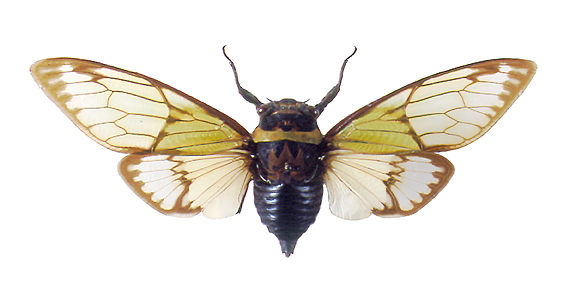
Hemiptera - The Bugs
The Hemiptera, for some reason, get the distinction of being dubbed "bugs". While the word "bug" is generally used to describe any or all arthropods, in binomial nomenclature it refers specifically to the Hemiptera. An incredibly diverse group of insects, they feed with the aid of piercing mouthparts enclosed in a beak-like rostrum, on both plants and animals. They have been broken into four suborders: Heteroptera (the true bugs), Auchenorrhyncha (the cicadas, lanternflies and hoppers), Sternorrhyncha (the aphids and scales), and Coleorrhyncha (the moss bugs). The ordinal name Hemiptera, is derived from Greek words meaning “half-wing”. Hemiptera appear in the fossil record during the Permian (280-225 million years ago). There are about 82,000 known species with more being described all the time.
 Milky Cicada (Ayuthia spectabilis)
Milky Cicada (Ayuthia spectabilis)
 Alligator-headed Lanternfly (Fulgora laternaria = Laternaria phosphorea)
Alligator-headed Lanternfly (Fulgora laternaria = Laternaria phosphorea)
 Sharpshooters (Oncometopia nigricans & Homalodisca sp.)
Sharpshooters (Oncometopia nigricans & Homalodisca sp.)
 Lanternfly (Penthicodes variegata)
Lanternfly (Penthicodes variegata)
 Giant Cicada (Pomponia imperatoria)
Giant Cicada (Pomponia imperatoria)
 Lanternfly (Pyrops viridirostris)
Lanternfly (Pyrops viridirostris)
 Cicadas (Tibicen spp.) Nymph and Adults
Cicadas (Tibicen spp.) Nymph and Adults
 Giant Leaf-footed Bug (Acanthocephala declivis)
Giant Leaf-footed Bug (Acanthocephala declivis)
 Green Stink Bug (Acrosternum hilare)
Green Stink Bug (Acrosternum hilare)
 Common Water Striders (Aquarius (=Gerris) remigis)
Common Water Striders (Aquarius (=Gerris) remigis)
 True Water Bugs (Belostoma sp.)
True Water Bugs (Belostoma sp.)
 Shield-backed Bug (Callidea signata)
Shield-backed Bug (Callidea signata)
 Tessaratomid Bug (Catacanthus incarnatus)
Tessaratomid Bug (Catacanthus incarnatus)
 Western Conifer Seed Bug (Leptoglossus occidentalis)
Western Conifer Seed Bug (Leptoglossus occidentalis)
 Giant Waterbug (Lethocerus americanus)
Giant Waterbug (Lethocerus americanus)
![]() Giant Red Bugs (Lohita grandis)
Giant Red Bugs (Lohita grandis)
 Tessaratomid Bugs (Oncomeris dilatus)
Tessaratomid Bugs (Oncomeris dilatus)
 Tessaratomid Bugs (Oncomeris flavicornis)
Tessaratomid Bugs (Oncomeris flavicornis)












